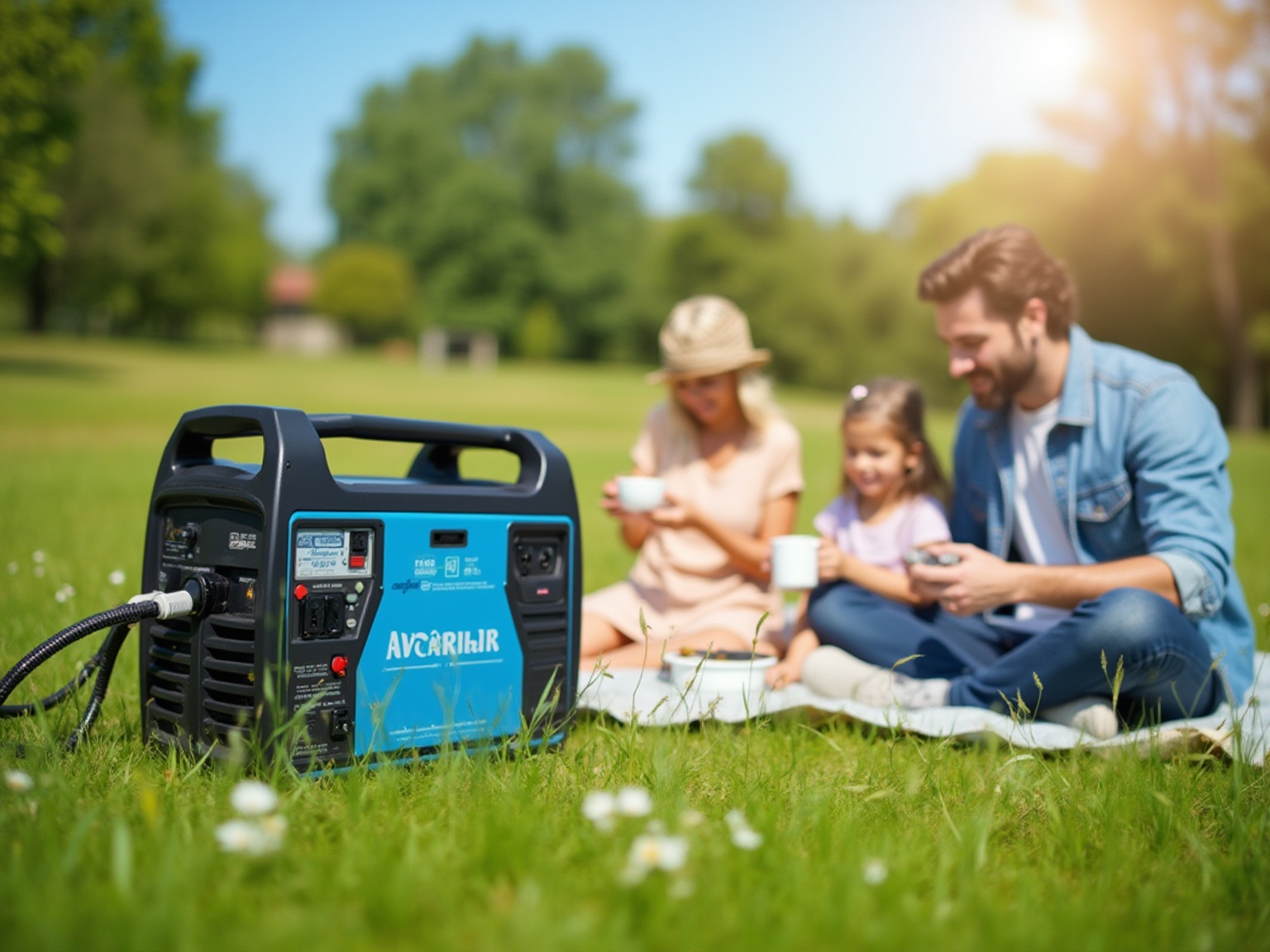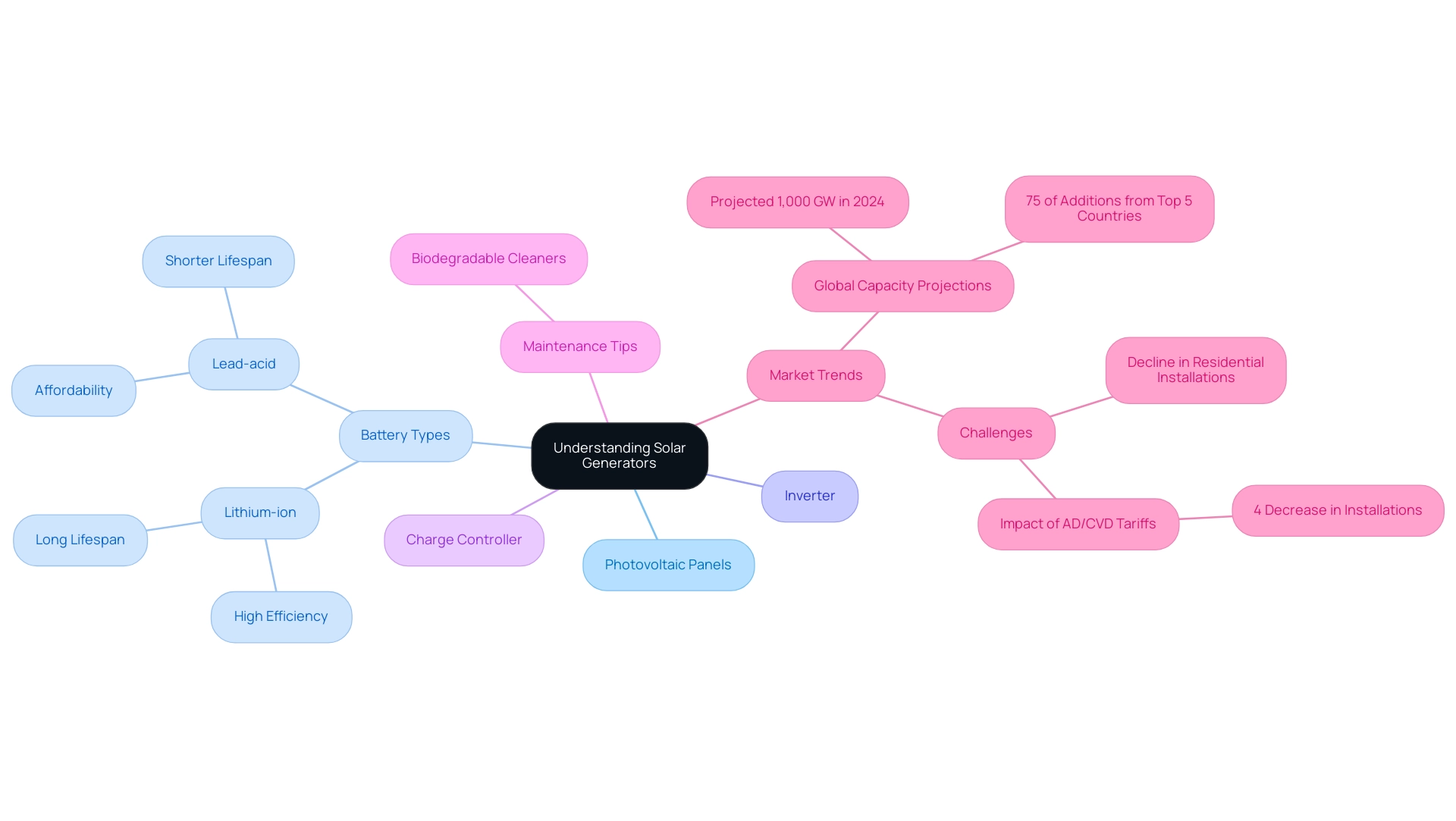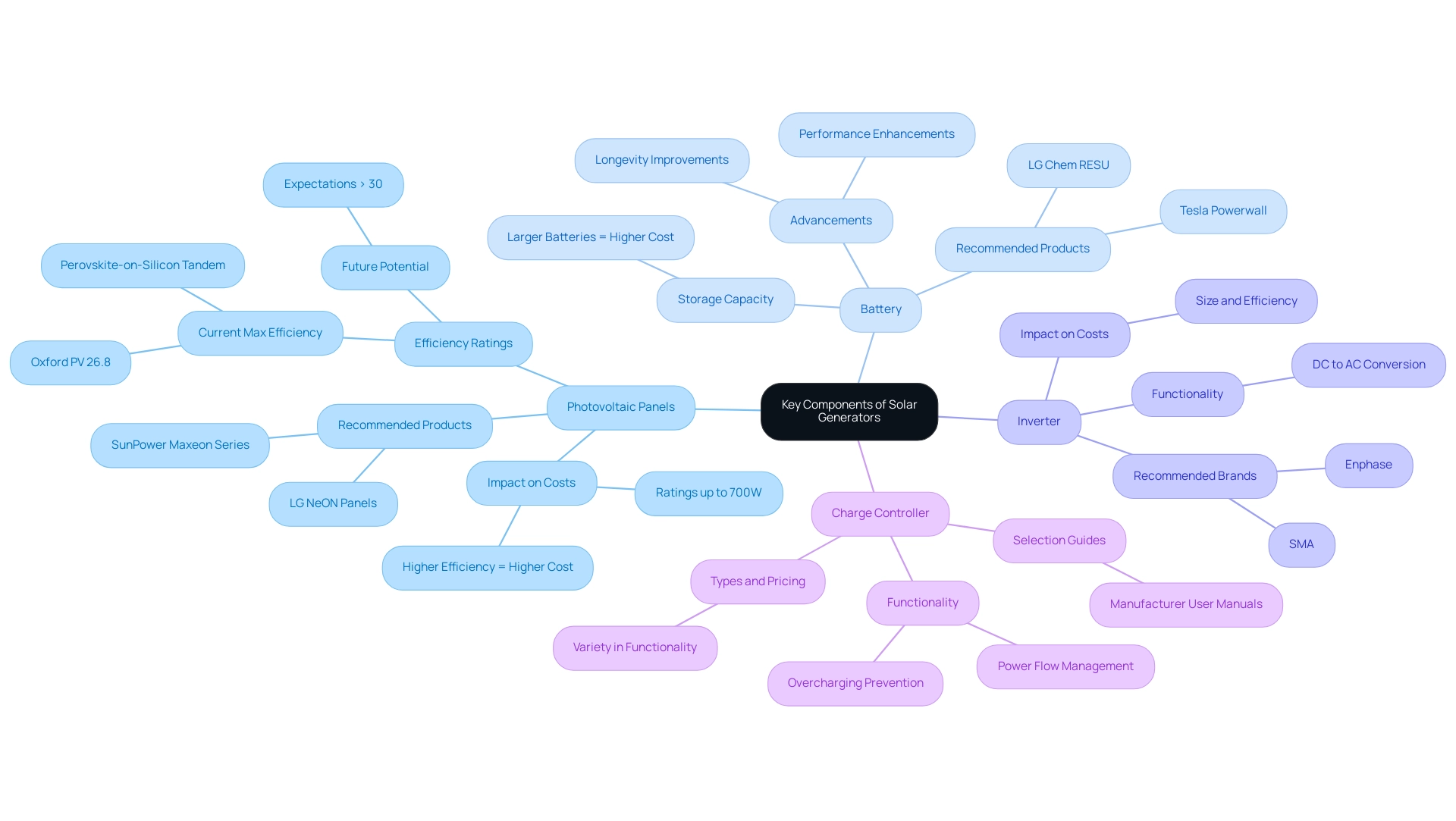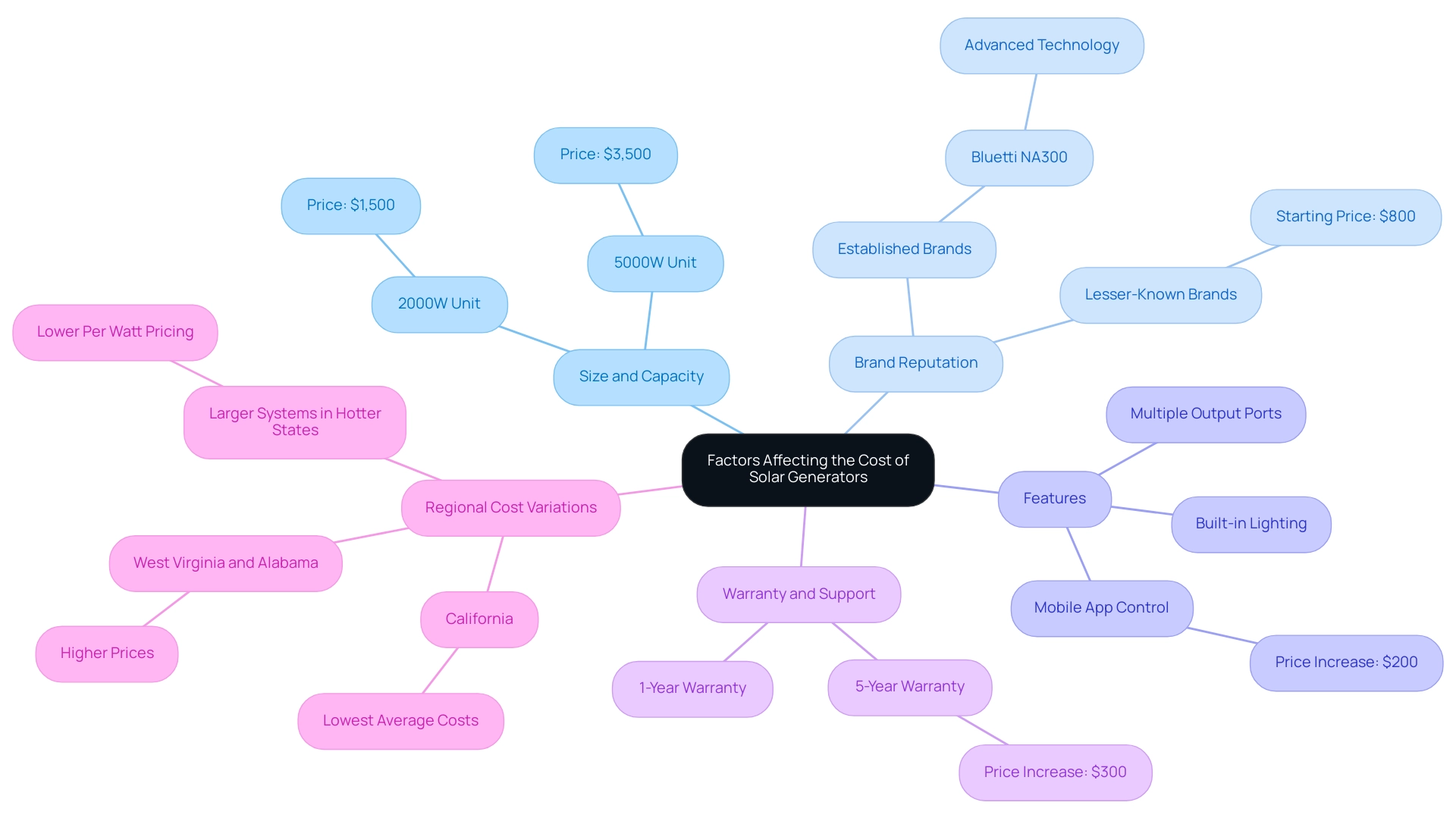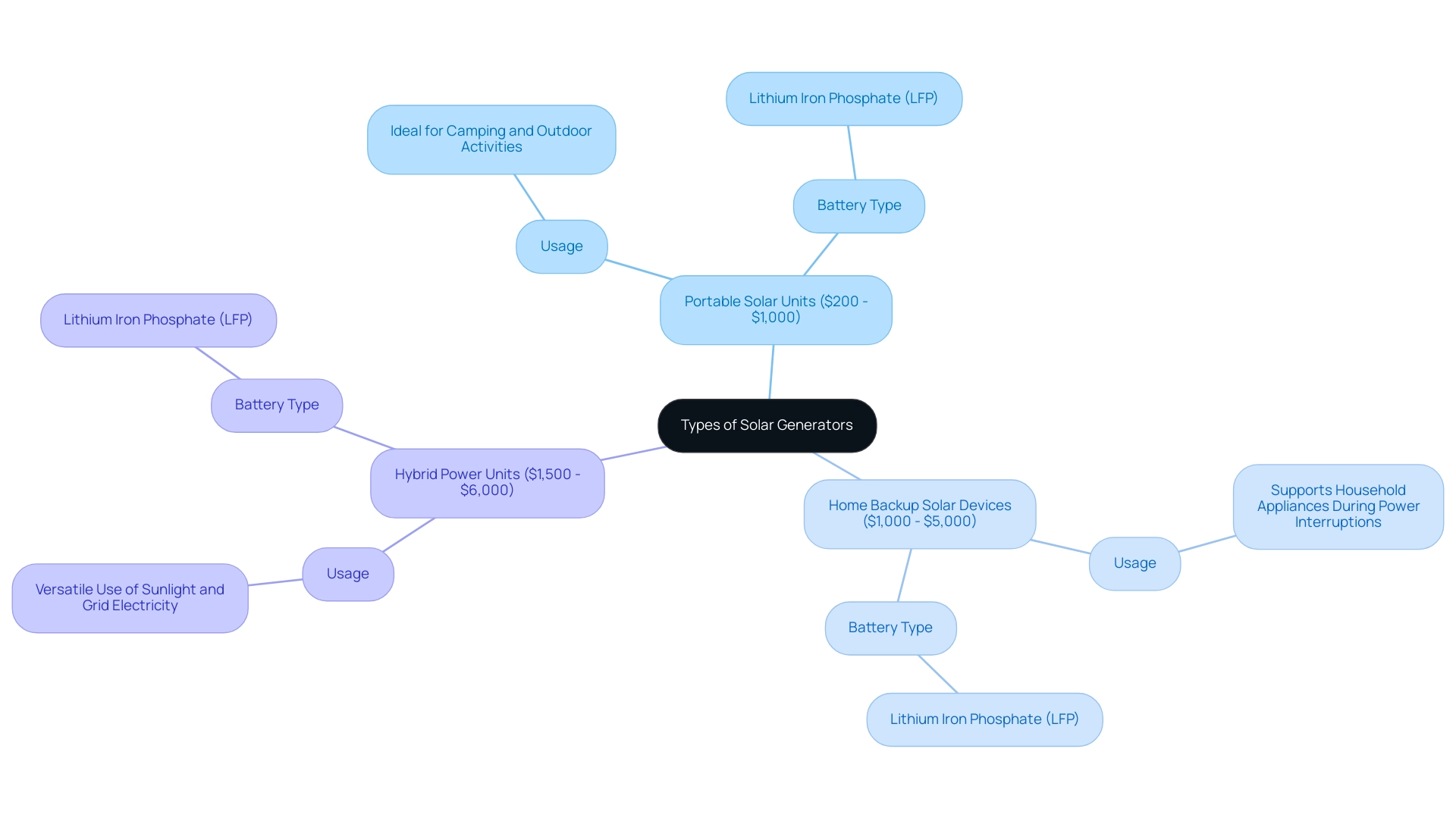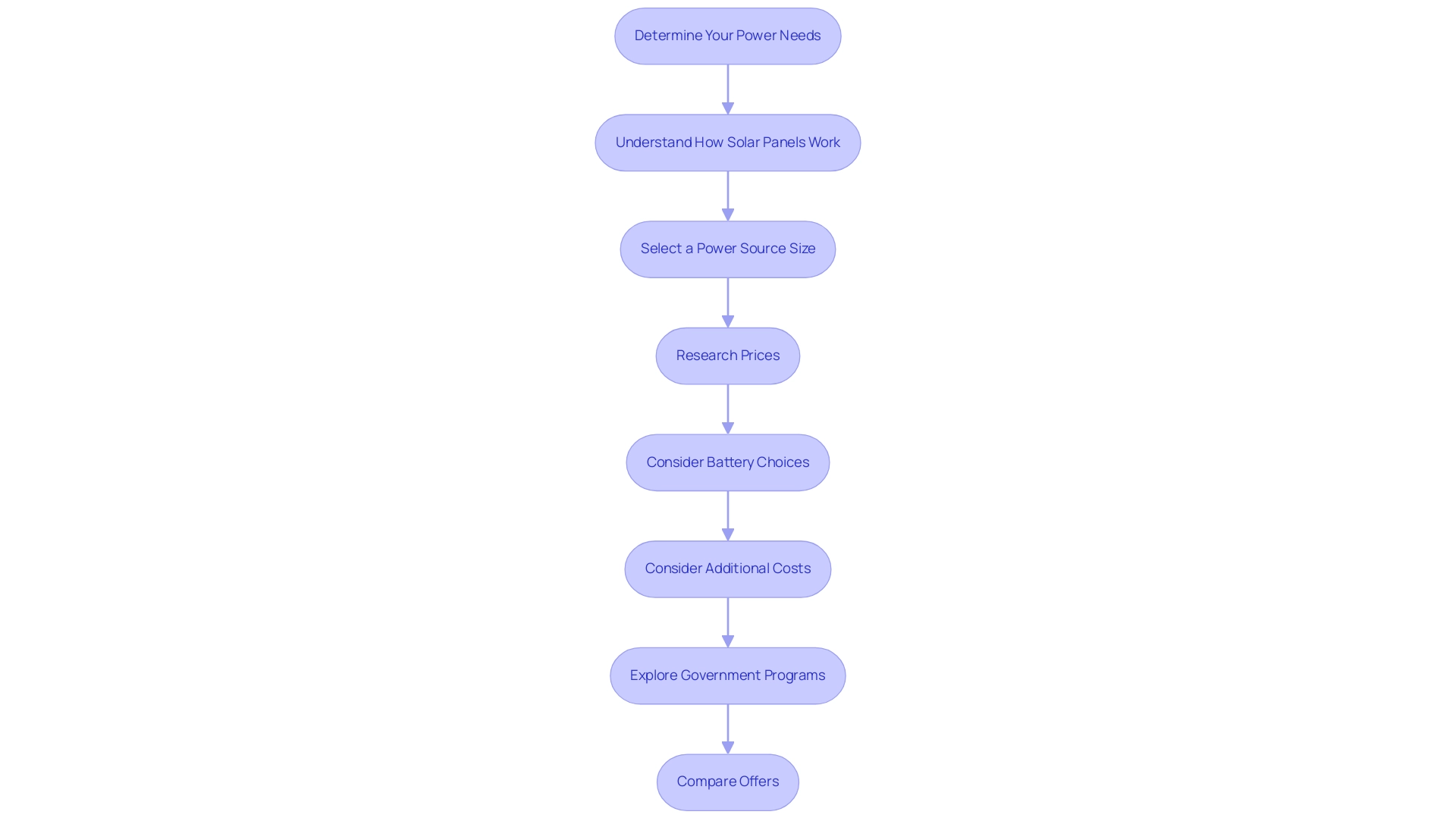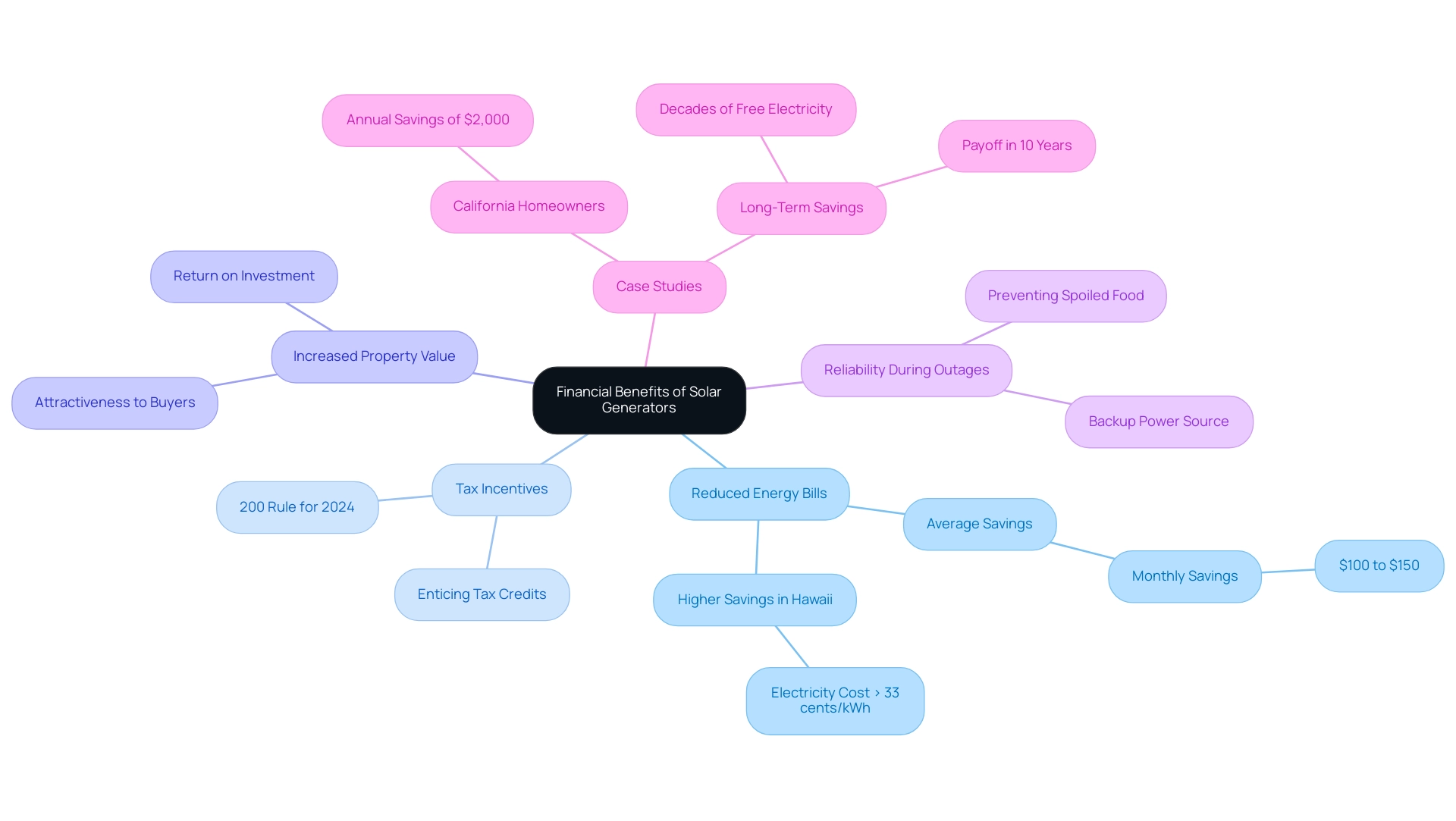Overview
Estimating the cost of a solar generator involves understanding the various components, including photovoltaic panels, batteries, inverters, and charge controllers, as well as factors such as size, brand reputation, features, and warranties. The article outlines a step-by-step calculation guide that helps homeowners assess their power needs and explore pricing options, emphasizing that the investment can lead to significant long-term savings on energy bills and potential tax incentives.
Introduction
As the world shifts towards sustainable energy solutions, solar generators are emerging as a powerful ally for eco-conscious homeowners. These innovative devices harness the sun’s energy, converting it into electricity through a sophisticated interplay of components, including:
- Solar panels
- Batteries
- Inverters
- Charge controllers
Understanding how these elements work together is crucial for maximizing energy efficiency and managing costs effectively. With the global push for renewable energy projected to surge, the popularity of solar generators reflects a growing desire for independence from conventional power sources.
However, navigating the myriad options available can be daunting. This article delves into the essential aspects of solar generators, covering:
- Key components
- Cost factors
- Types available
- Long-term savings
Empowering readers to make informed decisions on their journey toward sustainable living.
Understanding Solar Generators: What They Are and How They Work
Solar power systems are innovative, portable devices that harness sunlight and convert it into electricity through photovoltaic (PV) panels. Each unit generally consists of several essential parts:
- Photovoltaic panels that capture sunlight
- A battery for effective power storage
- An inverter that converts direct current (DC) into alternating current (AC)
- A charge controller that manages power flow
Grasping the synergy between these elements is essential for eco-conscious homeowners, as it directly influences energy management, sustainability, and overall expenses related to renewable energy systems.
When choosing a battery, it’s important to consider options like:
- Lithium-ion batteries, known for their high efficiency and long lifespan
- Lead-acid batteries, which are more affordable but have a shorter lifespan
Eco-friendly maintenance choices, such as utilizing biodegradable cleaners for photovoltaic panels, can also improve the efficiency and lifespan of energy systems. As the demand for renewable energy solutions rises—projected to reach nearly 1,000 GW in global manufacturing capacity in 2024—solar generators are becoming increasingly popular for powering small appliances, charging electronic devices, and serving as backup power sources during outages.
This versatility highlights the potential for maximizing panel output. Notably, the combined contributions of China, the United States, India, Germany, and Brazil are anticipated to represent 75% of global renewable energy additions in 2024, reflecting significant market dynamics. As stated by Nicolas Fulghum, Senior Data Analyst,
‘If this rate of additions is sustained, it would lead to a total installed capacity of 334 GW, making up 56% of global capacity additions for 2024.’
However, recent trends suggest a decrease in residential photovoltaic installations owing to elements such as increased financing expenses and the exhaustion of California’s project queue. Despite these challenges, progress in photovoltaic technology continues to improve the efficiency and affordability of energy systems, leading homeowners to consider how much does a solar generator cost while aiming to lessen their carbon footprint and effectively manage energy expenses.
Key Components of Solar Generators: A Breakdown of Essential Parts
The main elements of a photovoltaic system are essential for grasping both functionality and expenses:
- Photovoltaic Panels: These panels transform sunlight into electricity, with higher-efficiency models frequently demanding a premium price while providing improved long-term performance. Recent advancements have led to photovoltaic panels achieving efficiencies as high as 26.8%, such as the perovskite-on-silicon tandem units developed by Oxford PV. Notably, these panels can have ratings up to 700W, significantly influencing the overall cost-effectiveness of your energy generator. In September 2024, Oxford PV secured a commercial deal to supply panels with 24.5% efficiency for a small utility-scale project, reflecting ongoing innovations in solar technology. For homeowners, considering products like the SunPower Maxeon series or LG NeON panels can provide reliable options with high efficiency.
- Battery: Acting as a storage unit for power, the battery ensures availability even without sunlight. Its capacity directly affects the expense of the device; larger batteries offer more storage but are associated with a higher price. As battery technology advances, promising developments suggest potential enhancements in both performance and longevity, essential for homeowners pursuing independence. Products such as the Tesla Powerwall or LG Chem RESU are recommended for their efficiency and reliability.
- Inverter: This component converts stored direct current (DC) power into alternating current (AC) power, necessary for household appliances. The inverter’s dimensions and effectiveness greatly affect expenses, making it an essential factor in your energy system configuration. Seek inverters from trustworthy brands such as SMA or Enphase for peak performance.
- Charge Controller: Managing the power flow from photovoltaic panels to the battery, this device prevents overcharging and prolongs battery life. Different types of charge controllers can vary in price and functionality, emphasizing the need to choose one that suits your specific requirements. Guides on selecting the right charge controller can be found in user manuals from manufacturers.
Understanding these components and their roles aids in evaluating the initial investment and assessing how much does a solar generator cost, along with the long-term operational and maintenance costs associated with energy generators. Moreover, progress in Perovskite Cell Technology indicates efficiencies may surpass 30% in the future, further improving the cost-effectiveness of power systems. The economic benefits of investing in photovoltaic technology include significant savings on electricity bills, potential tax incentives, and increased property value, providing eco-conscious homeowners with robust options tailored to their energy needs.
Factors Affecting the Cost of Solar Generators: What to Consider
The price of renewable energy systems is affected by several important elements that environmentally aware homeowners should take into account:
- Size and Capacity: Generally, larger devices built to provide greater capacity are associated with higher price points. For example, a 2000W power source may cost around $1,500, while a 5000W unit could be priced at $3,500. Nonetheless, the improved power output they offer can validate this expenditure, particularly for individuals with substantial power requirements.
- Brand Reputation: The company behind a renewable power system plays a crucial role in its pricing. Established brands often command higher prices due to their reputation for quality and reliability. For instance, Bluetti recently launched the sodium ion solar device NA300, reflecting the advanced technology and reliability associated with its brand. This innovative device is designed to meet the growing demand for efficient energy solutions. Conversely, lesser-known brands may provide more competitive pricing, with models beginning as low as $800, albeit with different levels of performance and customer satisfaction.
- Features: The inclusion of advanced features, such as mobile app control, built-in lighting, and multiple output ports, can increase expenses. These features appeal to users looking for enhanced functionality and convenience. For instance, a device with app control might increase the price by an additional $200.
- Warranty and Support: Machines that provide extended warranties and exceptional customer support might involve higher upfront expenses, but they offer priceless reassurance for buyers. A power source with a 5-year warranty might cost $300 more than a comparable model with a 1-year warranty.
Additionally, it’s important to note that your electrical panel should be at least 200 amps to harness renewable energy, which is a crucial consideration for potential buyers evaluating their options. Comprehending these elements is crucial for evaluating the possible costs linked to different energy solutions, especially considering present market trends and technological advancements. Significantly, recent product introductions from firms like Jackery and EcoFlow demonstrate innovations that not only enhance performance but also affect pricing dynamics in the renewable energy market.
Furthermore, regional cost variations in photovoltaic installation illustrate how location impacts pricing dynamics, providing a comprehensive understanding of the market. To select the optimal solar power source, evaluate your power requirements, budget, and the particular characteristics that will advantage your home.
Types of Solar Generators: Choosing the Right One for Your Needs
Solar power systems are classified into several unique varieties, each designed to fulfill particular power requirements for environmentally aware homeowners:
- Portable Solar Units: These lightweight and easily transportable devices are ideal for camping and outdoor activities. Their price typically ranges from $200 to $1,000, leading to the question of how much does a solar generator cost, making them accessible for occasional users.
- Home Backup Solar Devices: Designed to assist household appliances during power interruptions, many people wonder how much does a solar generator cost, as these units can range from $1,000 to $5,000 depending on their capacity and features. Their robust design ensures that essential devices remain operational when grid power is unavailable.
- Hybrid Power Units: Providing the versatility to use both sunlight and grid electricity, hybrid units offer adaptability for different power scenarios. The costs for these units, which range from $1,500 to $6,000, lead many to wonder how much does a solar generator cost, considering their sophisticated features and technology.
The selection of a power source not only impacts the upfront expenditure but also influences ongoing operational expenses and compatibility with your power requirements. Notably, all tested portable solar generators utilize lithium iron phosphate (LFP) battery cells, renowned for their safety, stability, and longevity. According to Bradley Ford, a Test Editor, ‘The longevity and reliability of these batteries make them a preferred choice for consumers seeking sustainable power solutions.’ Newer LFP batteries can last up to 10 to 15 years, reinforcing their value for eco-conscious homeowners.
Moreover, the case study titled ‘Battery Chemistry Consideration’ emphasizes how LFP batteries, although heavier, are preferred for their non-toxic characteristics and considerably longer lifespan in comparison to other battery chemistries, making them a great choice for those prioritizing reliability. For Long Beach tenants, it’s also essential to investigate available government initiatives and incentives that can help reduce the expenses related to acquiring renewable power systems, making sustainable solutions more attainable. These programs often provide financial assistance or tax credits, further enhancing the value of investing in renewable technology.
Estimating Your Solar Generator Costs: A Step-by-Step Calculation Guide
Calculating the expenses linked to a photovoltaic system involves several essential steps that can assist you in making knowledgeable choices in your pursuit of sustainable energy options:
- Determine Your Power Needs: Begin by calculating the wattage of the devices you intend to power. For example, a washing machine consumes approximately 1900 watts, while a tumble dryer uses around 2300 watts. Additionally, consider other appliances, such as smart thermostats, which use between 2 to 7 watts. Comprehending these figures is crucial for precise evaluations, assisting you in aligning your choices with optimal panel functionality.
- Understand How Solar Panels Work: Solar panels convert sunlight into electricity using photovoltaic cells. This process involves absorbing sunlight, which excites electrons and generates direct current (DC) electricity. An inverter then converts this DC electricity into alternating current (AC), which powers your home. Understanding this procedure can assist you in comprehending how your power source will connect with your energy system.
- Select a Power Source Size: With your power needs established, choose a device that can accommodate the required capacity. A renewable energy source should ideally surpass your total wattage requirements to guarantee dependable operation during peak usage, essential for efficient energy storage.
- Research Prices: Explore how much does a solar generator cost as well as pricing for various generator types both online and at local retailers. Keep in mind that prices can vary significantly based on features and brand reputation, including emerging options like Tesla home chargers that enhance your energy experience.
- Consider Battery Choices: When selecting a battery for power storage, consider options such as lithium-ion batteries, which are known for their efficiency and longevity. Understanding the best battery choices can help you maximize your solar energy usage and ensure that you have power when you need it most.
- Consider Additional Costs: Beyond the generator’s price, consider how much does a solar generator cost when factoring in installation, regular maintenance, and potential financing options that may arise. For example, while a kilowatt meter can be purchased for around $30 when new and $10 when used, helping you track power consumption effectively, this expense is crucial in your overall budget. Furthermore, comprehending the power usage of alternative systems, like a heat pump water heater that uses 111.8 kWh monthly at a price of $16.88, can offer important insights into your efficiency and expense comparisons.
- Explore Government Programs: Investigate local and federal government initiatives that provide incentives for renewable power adoption. These initiatives can greatly decrease your total expenses and make renewable power more attainable for environmentally aware homeowners.
- Compare Offers: Finally, evaluate different brands and models to identify the best deal. As noted by a leading expert, Solar Addict,
Best thing you can do is get a kilo-o-watt meter or just clamp a wire from a breaker to see what it’s drawing.
This method will offer significant understanding of your power consumption and help in making a comprehensive choice.
By diligently adhering to these instructions, including staying updated on the newest in renewable solutions, you’ll reach an estimated expense customized to your individual requirements and desires. This guarantees that your investment in renewable sources is both practical and efficient, contributing to long-term sustainability in your home.
Long-Term Savings: Evaluating the Financial Benefits of Solar Generators
Investing in a renewable energy generator can yield remarkable long-term financial benefits, particularly for eco-conscious homeowners. Here are some key advantages to consider:
- Reduced Energy Bills: Utilizing photovoltaic energy diminishes dependence on grid electricity, leading to potential reductions of $100 to $150 in monthly electric bills, depending on system size and location. In areas like Hawaii, where electricity costs exceed 33 cents per kWh, the savings can be even more substantial. For instance, an average 5 kW residential energy system can save homeowners between $100 to $150 monthly, illustrating significant potential savings.
- Tax Incentives: Many regions offer enticing tax credits or rebates for purchasing energy equipment, significantly alleviating the initial investment. For 2024, these incentives are particularly appealing, enhancing the affordability of installations under the 200% Rule.
- Increased Property Value: Homes equipped with renewable energy solutions typically enjoy elevated property values, making them more attractive to prospective buyers. This increase in value can signify a considerable return on investment for property owners contemplating renewable energy.
- Reliability During Outages: Photovoltaic systems offer a reliable backup power source during outages, potentially saving money on spoiled food and preventing disruption to work and daily activities.
- Case Studies: For instance, homeowners in California have reported savings of up to $2,000 each year after installing photovoltaic systems, demonstrating the real-world financial impact of these investments. According to Professor Gilbert Michaud from Loyola University Chicago, ‘Most systems pay themselves off in about 10 years. Then you have decades of free electricity after that.’ This emphasizes the significance of assessing long-term savings, presenting a persuasive argument for the initial investment in energy generators. Considering that fifteen years of savings at $1,500 each year totals $22,500, it is crucial to recognize the long-term financial impact of these investments. However, it is also important to understand the limitations of savings estimates, as noted by SolarReviews, particularly regarding long-term accuracy and future utility rates. Additionally, a detailed cost analysis shows that while the average installation cost for a solar system can range from $15,000 to $25,000, knowing how much does a solar generator cost along with the long-term savings and incentives can significantly offset this initial expenditure.
Conclusion
Investing in solar generators represents a significant step toward sustainable living and energy independence. By understanding the key components—solar panels, batteries, inverters, and charge controllers—homeowners can make informed choices that optimize energy efficiency and cost-effectiveness. The evolving technology and competitive market landscape highlight the importance of selecting the right type of generator based on individual needs, whether for:
- Portable use
- Home backup
- Hybrid solutions
Cost considerations play a vital role in the decision-making process. Factors such as size, brand reputation, features, and warranty options can influence initial investments, while potential long-term savings are substantial. Homeowners can anticipate:
- Reduced energy bills
- Tax incentives
- Increased property values
All contributing to a compelling financial case for solar generators.
As the push for renewable energy continues to grow, so does the accessibility and affordability of solar solutions. By evaluating power needs, exploring government incentives, and keeping abreast of technological advancements, eco-conscious individuals can embrace solar generators as a viable and rewarding option for their energy needs. The shift towards renewable energy not only aids in reducing carbon footprints but also fosters a sustainable future for generations to come.


